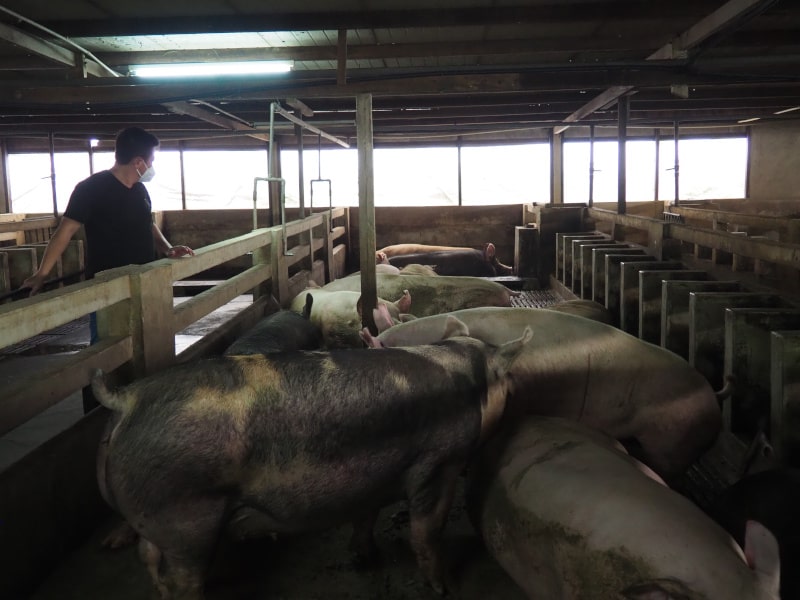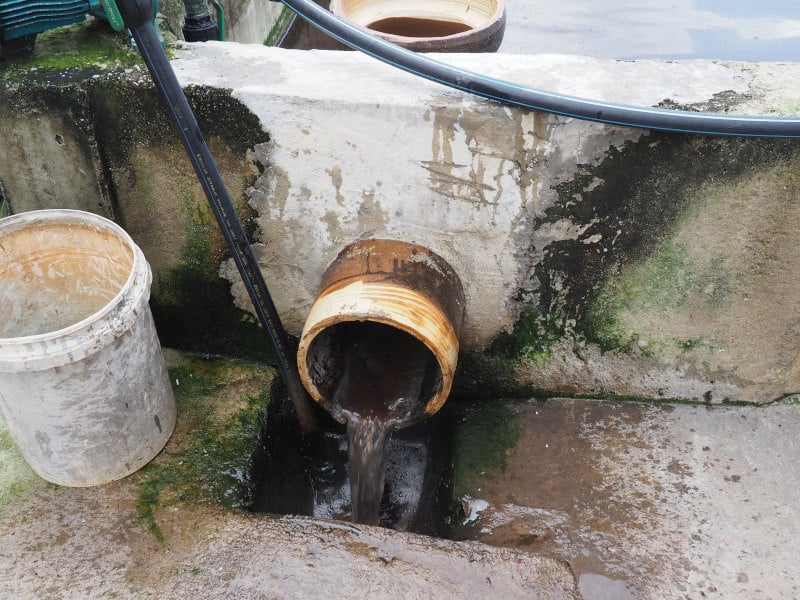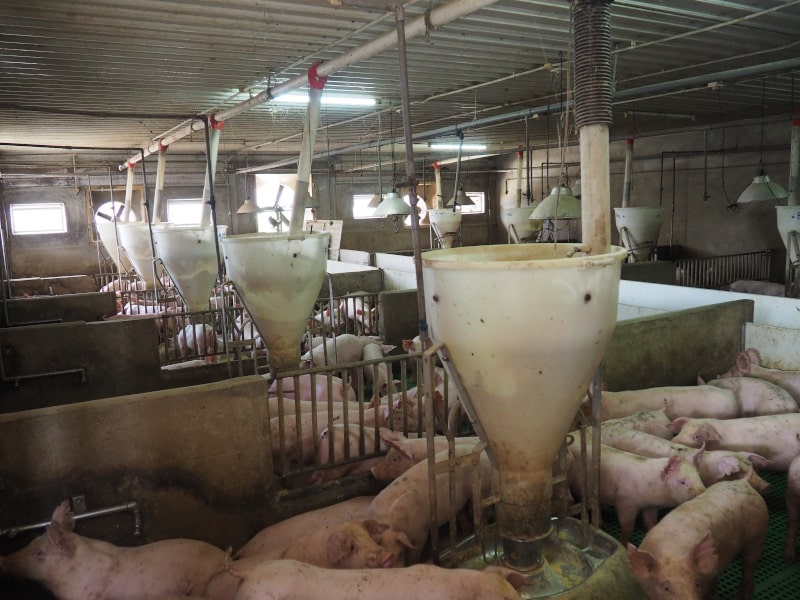Content warning: This blog post contains photos of factory farming that viewers may find distressing.

45-year-old pig farmer Mr. Wong glances over his pigs. Spanning over four hectares, he raises 2,500 pigs with the help of his workers before weighing and delivering them to nearby slaughterhouses. What happens when a person’s livelihood displaces another? Photo taken by author.
Pigs squeal and scream as they lie down in group pens. The humid air in the foreground, the farm’s pipes churn out pig waste into the nearby river. This is Kampung Selamat, an industrialized area known for factory farming in mainland Penang, Malaysia. Its river, known as Sungai Kreh, is the living chronology of industrialized pollution. Since the 1980s, the river has turned from bright blue to lime green as 72 pig farms discharge antibiotics, pig feces, and pig carcasses into the water. The foul stench and waste reveal how intertwined pig lives are with the personal livelihood of Kampung Selamat’s villagers over time.

Pig waste is filtered by Mr. Wong’s farm, entering Kampung Selamat’s river. Mr. Wong has been informally mediating conversations between pig farmers and villagers affected by the pollution. Photo taken by author.
A series of journalistic projects put me in close proximity to pig farms adjacent to oil palm plantations. Rather than tracing the oil palm as a commodity in itself, I started to examine the violent multispecies entanglements that came out of its plantations. My field reporting resulted in the emergence of several key conceptual questions – the kind of abstract thinking that didn’t really belong in the journalistic genre.
My writing does not predict the actual state of historical reality. Rather, I write about the affective dimensions of the political economy we neglect to think about when disease outbreaks disrupt animal trade. This piece is about cultivating interspecies relationality under capitalist constraints.
How do we treat pandemics when they happen to other animals? What do we learn from a more-than-human[1] One Health? In this blog post, I attempt to explore how the oil palm belt’s power dynamics and capitalistic production processes facilitate multispecies entanglements in contemporary political economy.
Cultivating More-than-Human One Health

Piglets housed in the nursery section of Mr. Wong’s farm. Photo taken by author.
One Health is a health policy framework that promotes both human and nonhuman health while taking into account environmental factors. Traditionally, intergovernmental institutions such as the Food and Agriculture Organization of the United Nations (FAO) interpret One Health as an approach to “sustainably balance and optimize the health of people, animals, and ecosystems”. While other scientific institutions such as the World Organisation for Animal Health (OIE-WAHIS) operate on a One Health approach that see both human and nonhuman animal health as both intertwined and interdependent. These perspectives differ in that some scientific/governmental institutions prioritize the care of human health over nonhuman health during zoonotic disease outbreaks. They do not see nonhuman counterparts as collaborators who play a significant role in the worlds we inhabit, but rather as biosecurity threats who have the potentiality to disrupt supply chains and economic productivity.
One Health’s lack of analysis on tracing human exploitation of factory farming activities is an oversight because it reveals the unidirectional and asymmetrical directionality in viewing nonhuman animals as primarily instrumental for learning about human health first. A More-than-Human One Health urges scientists and everyday people to propose solutions that address dangers for all human and nonhuman beings across different geographical settings (Sellars, Bernotas, & Sebo, 2021:39). For example, it analyzes how industrialized pig farms facilitate profit-optimization practices, such as housing pigs in tight gestation crates and artificial inseminating sows rendering pigs as a food commodity first — permits the reconstituting pigs into biosecurity threats when they fall sick. As farmers raise more pigs with fewer resources, the industrialized pig farm becomes more susceptible to zoonotic diseases. Specifically, scientists and wildlife conservationists are trained to conduct research on nonhuman health to learn more about maintaining the viability of human health, mostly, at the cost of nonhuman lives (Sellars, Bernotas, & Sebo, 2021:39).
Domestication (Slowly) Dies Out

Sows lie down in gestation crates. Mr Wong says, “there is a high cost of breeding and no benefits” because he imports breeding pigs from Iowa, United States. He also has farming debt to pay off. Photo by author.
African Swine Fever (ASF) is a viral disease affecting both domesticated and wild pigs across 32 countries, killing over 1.5 million pigs in 2020-2021. With a near 100% mortality rate, ASF-infected pigs experience painful symptoms such as vomiting, skin hemorrhages, and loss of appetite. The virus is able to survive on pig carcasses, pork products, and human clothes — even human caretakers play an important role in maintaining the liveability of pigs until their slaughter. Although the virus is lethal only to pigs, this pandemic tells us a lot about how humans treat other animals when diseases do not threaten human health.
In early February 2021, Malaysia reported its first ASF outbreaks in Sabah. With no vaccine, state veterinarians culled 3,000 pigs in March 2021 as ASF outbreaks occurred across factory farms, forest reserves, and oil palm plantations. These differential procedures of medical care reveal how the wellbeing of domesticated pigs is prioritized over wild pigs. For example, Malaysian veterinarians announced research plans to develop a vaccine for domesticated pigs but did not reveal much about treatment plans for wild pigs. Domesticated pigs serve as agricultural livestock for food consumption while wild pigs are despised for disrupting palm oil activities.
These pig cullings do not address nonhuman suffering but rather are a series of responses toward socioeconomic productivity disruption during ASF. Media outlets in Malaysia have primarily focused on how pig farmers and Indigenous communities have lost their socioeconomic livelihood during the ASF outbreaks. By focusing on human impacts, media narratives commodify pigs as food sources rather than recognizing pigs as individual beings who play significant roles in cultural settings and tropical rainforest ecosystems.
Historically, One Health approaches have not focused much on human exploitation of nonhuman lives in factory farming, deforestation, and other extractive industries (Sellars, Bernotas, & Sebo, 2021:36). For example, industrialized pig farms built adjacent to forestlands in Malaysia facilitated the transmission of the Nipah Virus, enabling pigs to become intermediary hosts. By placing these domesticated pigs in contact with wildlife such as bats, Nipah virus outbreaks occurred Because of its zoonotic origins, the Malaysian army urgently shoved and shot 1 million pigs in pits.
Gardeners of the Forest/Destroyers of Palm Oil

A wild boar (sus scrofa vittatus) roams a forest in Pahang, Malaysia. The wild boar is often seen as a “pest” by oil palm plantation managers. Photo by Wikimedia Commons.
In Peninsular Malaysia, wild pigs facilitate forest tree biodiversity by constructing birthing nests using diverse tree saplings. Their treatment is paradoxical; as environmental scientists praise wild pigs for their ecosystem services, they are despised by oil palm managers for disrupting monoculture processes by eating palm oil fruits.
The plantation facilitates the large-scale, monoculture extraction of palm oil in countries such as Malaysia and Indonesia. It is also the dominating political technology in exploiting human and nonhuman labor, reshaping multispecies entanglements, and commodifying land. In fact, the plantation resembles a present-day colonial regime of extractive capitalism that favors corporations (Li, 2021: 21 & 182).
As palm oil production rapidly engulfs rural land, wildlife conservationists failed to recognize the parallel displacement of undocumented Indonesian migrants and “common” animals such as pigs. Local conservation dynamics enforced violent multi-species entanglements in line with colonial histories of domination and hypermasculine imaginaries of human agency over nonhuman animals.
While the state views wild pigs as pests because of their ability to disrupt palm oil production, these pigs serve as a source of food for often marginalized migrant groups such as the Indonesian migrants who work in oil palm plantations. In Malaysian Borneo, Indigenous communities such as the Kadazandusun-Murut ethnic group hunt bearded pigs for their personal livelihood and to partake in cultural traditions.
Oil palm managers may use technologies such as guns, camera traps, and fence installations. This technological assemblage conveys a narrative of anthropocentric domination over nonhuman animals who disrupt the oil palm belt’s extractive processes. The oil palm belt thrives at the expense of nonhuman animal lives.
Deforestation not only displaces both human and nonhuman communities but also “increases the risk of zoonotic disease spread by increasing interaction between humans and nonhumans and by reducing biodiversity which functions as a buffer for the spread of zoonotic diseases” (Sellars, Bernotas, & Sebo, 2021: 38). As accelerated rates of deforestation pave the way for factory farms & monoculture plantations in Malaysia, both human and nonhuman health risk further deterioration through frequent zoonotic outbreaks. The risk of climate-driven disease exacerbates future pandemics because people are more likely to interact with infected animals as more areas are deforested.
Conclusion
When scientific technologies are used to control nonhuman populations, bureaucrats claim it is “acting in the name of efficiency or rationality” (Graeber, 2015: 38). However, as David Graeber states, the values of such bureaucratic structures and processes never come to light. Instead, these values remain hidden in thick layers of paperwork we are usually forced to navigate and fill out.
As Graeber says, “structural violence creates lopsided structures of the imagination” (Graeber, 2015: 81). An anthropocentric One Health, which categorizes nonhuman animals as biosecurity threats exclusively, lends itself to framing multispecies relationships as unidirectional and asymmetrical in terms of power dynamics favoring human control. A more-than-human One Health has the potential to decenter the human at the core of prioritizing wellbeing and care. Humans need to stop seeing nonhuman animals as commodities under extractive capitalism and start conceptualizing ways to care for nonhuman health. We also need to disrupt large-scale industrial activities — these activities contribute to destroying our cultural worlds and facilitate violent multispecies entanglements consequential to our health.
Reflecting on both Nipah Virus and African Swine Fever outbreaks, it is not about the scientific verification in showing the totality of pig deaths. Instead, we should see pigs as individual beings who contribute and play significant roles in the worlds we co-inhabit with. A More-than-Human One Health approach encourages cooperation among humans and nonhumans in facilitating interspecies solidarity. Perhaps, we can start by imagining post-extractivist imaginaries beyond using a negative conceptual registry of post-apocalyptic worlds. Academic spaces have the intellectual and creative capacity to trace the life and death cycles of nonhuman animals beyond extractive narratives. As our worlds become more susceptible to pandemics, the porous demarcation between domesticated/wild and human/nonhuman reveals the fragility of life under capitalism.

Mr. Wong is eager to expand his business through ventures such as genetic experimentation and pig methane energy. He fears African Swine Fever will wipe out his animals. Photo taken by author.
Notes
[1] The term “more-than-human” refers to how humans have always been entangled with other animals and nonhuman entities across our cultural worlds & historical situations (O’Gorman and Gaynor 2020).
Acknowledgments
Thank you to Professor Andrew Flachs and the Platypus editors for their feedback.
References
Blanchette, Alex. May 2020. Porkopolis. Duke University Press.
Box, Olivia. January 2022. The One Health Framework. JSTOR Daily. https://daily.jstor.org/the-one-health-framework/
Doucleff, Michaeleen & Greenhalgh, Jane. February 2017. NPR. A Taste for Pork Helped A Deadly Virus Jump to Humans. https://www.npr.org/sections/goatsandsoda/2017/02/25/515258818/a-taste-for-pork-helped-a-deadly-virus-jump-to-humans
Food and Agriculture Organization of the United Nations. 2021. One Health Definition https://www.fao.org/one-health/en
Govindrajan, Radhika. May 2018. Animal Intimacies: Interspecies Relatedness in India’s Central Himalayas. University of Chicago Press.
Graeber, David. 2015. The Utopia of Rules: On Technology, Stupidity, and the Secret Joys of Bureaucracy. Melville House Publishing.
Guynup, Sharon. February 2022. Preventing the Next Pandemic is Vastly Cheaper than Reacting to It. Mongabay. https://news.mongabay.com/2022/02/preventing-the-next-pandemic-is-vastly-cheaper-than-reacti ng-to-it-study/
Luskin, Matthew, Kurz, David, Saikim, Fiffy Hanisdah, and Potts, Matthew. September 2021. ‘The Pigs Can Smell Man’: How Decimation of Borneo’s Ancient Rainforests Threatens Hunters and the Hunted. The Conversation. https://theconversation.com/the-pigs-can-smell-man-how-decimation-of-borneos-ancient-rainforests-threatens-hunters-and-the-hunted-166895
Moore, Jason. August 2015. Capitalism in the Web of Life. Verso Books.
Murray Li, Tania. December 2021. Plantation Life: Corporate Occupation in Indonesia’s Oil Palm Zone. Duke University Press.
Nor, Aron. December 2021. Where are the pigs? African Swine Fever in Deadly Assemblages. Just Wondering…https://youtu.be/Q5L4JPc2fdQ
O’Gorman, Emily & Gaynor, Andrea. October 2020. More-Than-Human Histories. University of Chicago Press. https://www.journals.uchicago.edu/doi/full/10.1093/envhis/emaa027
Sellars, Laurie, Bernotas, Kimberly, and Sebo, Jeff. December 2021. One Health, COVID-19, and a Right to Health for Human and Nonhuman Animals. Health and Human Rights Journal.
World Organisation for Animal Health. One Health. https://www.oie.int/en/what-we-do/global-initiatives/one-health/
Yu, Charles. April 2020. The Pre-pandemic Universe Was the Fiction. The Atlantic. https://www.theatlantic.com/culture/archive/2020/04/charles-yu-science-fiction-reality-life-pand emic/609985/
